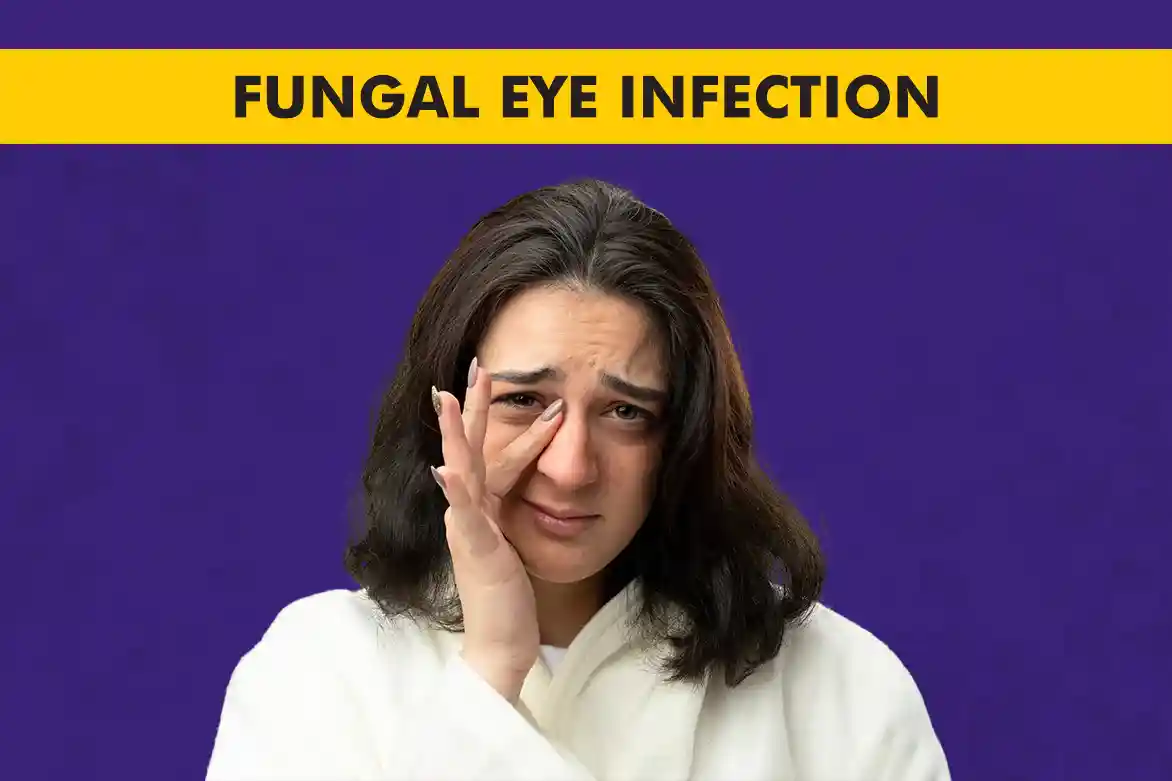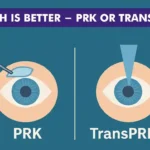Fungal infections of the eye are a rare but serious medical concern that requires timely diagnosis and appropriate care. Although they may sound intimidating, it’s reassuring to know that in most cases, when detected early, they are treatable and prevent long-term damage.
These infections often progress slowly, but if left untreated, they can lead to vision loss or complications. One of the most important steps toward effective care is understanding the causes of fungal eye infections, which allows patients and healthcare providers to identify risks early and take preventive action.
This blog offers an in-depth overview of what causes fungal infections in the eye, the associated symptoms, standard treatments, including fungal keratitis, and practical eye fungal infection home remedies that may support recovery in mild cases.
Meaning
Fungal eye infections occur when fungi invade and multiply within the eye’s tissues. This condition is most frequently seen in the form of fungal keratitis, an inflammation of the cornea—the clear, dome-shaped surface that covers the front of the eye.
Fungal infections can affect various eye structures, including the cornea, conjunctiva, sclera, or internal compartments.
Many people feel unsure or worried upon hearing terms like fungal keratitis, but understanding what’s happening inside the eye can offer clarity and control during the treatment.
Fungi are present in the environment and are often harmless, but under certain conditions, they can penetrate the ocular surface and lead to infection.
Common Types of Fungal Eye Infections
Fungal eye infections can be classified based on the type of fungus involved and the part of the eye affected. Knowing what type of infection you have helps you and your doctor find the right solution, and can ease some of the worry that comes with uncertainty.
Fungal keratitis
This is the most well-known type of fungal eye infection. It typically occurs after an eye injury, especially with organic material like plant matter. Filamentous fungi such as Fusarium and Aspergillus are commonly responsible.
Endophthalmitis
Fungal endophthalmitis is a more severe internal infection of the eye. It may result from systemic fungal infections or after eye surgeries.
Conjunctivitis and blepharitis
While rare, fungi can also affect the conjunctiva and eyelids, causing symptoms that may be confused with more common bacterial or viral infections.
Main Causes of Fungal Eye Infection
There are several known causes of fungal eye infections, each with its mechanism of action. These causes often relate to everyday events, like minor eye injuries or lens habits, which means that with small changes, the risk can be greatly reduced.
Trauma with vegetative matter
One of the most frequent causes is injury to the eye involving soil, plant materials, or wood. Such injuries introduce fungal spores directly into the eye.
Improper contact lens hygiene
Wearing contact lenses for extended periods or using contaminated lens solution can allow fungi to proliferate on the eye’s surface.
Immunosuppression
Individuals with weakened immune systems, whether due to chronic illness or medication, are more vulnerable to fungal infections.
Pre-existing eye conditions or surgeries
Patients who have undergone recent eye surgeries or those with chronic eye surface diseases are at higher risk.
Environmental exposure
Living or working in warm, humid, or dusty environments increases exposure to airborne fungal spores.
Understanding the causes of these fungal eye infections helps develop personal and clinical prevention strategies.
Risk Factors of Fungal Eye Infection
In addition to direct causes, certain risk factors heighten susceptibility:
- Agricultural work or outdoor labour
- Use of corticosteroid eye drops
- Existing corneal ulcers or abrasions
- Autoimmune disorders or diabetes
- Previous ocular surgery or trauma
- Extended use of contact lenses without cleaning
Being at higher risk doesn’t mean infection is inevitable. Knowing where you stand simply helps you take smarter steps to protect your vision.
These conditions may not directly cause the infection but can create an environment conducive to colonising fungi. If any of these apply to you, a quick chat with your eye doctor can make a big difference.
Symptoms of Fungal Eye Infection
Experiencing discomfort in your eyes can be both distressing and disruptive to daily life, whether it’s reading, working, or simply enjoying the world around you. Recognising fungal eye infection symptoms early improves the chances of effective management.
Common signs include:
- Redness and eye pain
- Decreased vision or blurry sight
- Excessive tearing or discharge
- Light sensitivity
- Foreign body sensation in the eye
- A white or greyish corneal spot
- Swelling around the eye
If any fungal eye infection symptoms persist or worsen, a consultation with an eye specialist is recommended.
Diagnosis of Fungal Eye Infection
If you are nervous about getting your eyes checked, know that these procedures are typically painless and quick. Taking this step early can offer peace of mind and protect your vision.
Slit-lamp examination
This magnified view allows the ophthalmologist to detect corneal ulcers or infiltrates.
Corneal scraping
A sample from the infected area is taken and sent for fungal culture and microscopic evaluation.
Staining tests
Special dyes such as KOH (potassium hydroxide) can help identify fungal elements under a microscope.
Imaging
In severe cases or suspected internal infections, ocular imaging may be necessary to assess deeper eye structures.
A precise diagnosis is critical before initiating fungal eye infection treatment, as antifungal therapy differs from antibacterial approaches.
Fungal Eye Infection Treatment
Effective fungal eye infection treatment often depends on the specific type of fungus involved and the extent of infection. Your eye specialist will guide you through options that are suited to your condition and comfort.
Topical antifungal medications
Natamycin is commonly prescribed for superficial fungal keratitis. Other options include amphotericin B or voriconazole.
Oral antifungal agents
Oral medications such as fluconazole or itraconazole may be required in cases of deeper or systemic involvement.
Intravitreal injections
Antifungal agents may be injected directly into the eye for internal infections like endophthalmitis.
Surgical intervention
In severe or unresponsive cases, surgical procedures such as corneal transplantation and glaucoma surgery can be scheduled, which may be necessary to restore vision or control infection.
Prompt initiation of fungal eye infection treatment can preserve vision and prevent complications, particularly when the infection is diagnosed early.
Fungal Eye Infection Home Remedies
Home remedies may provide a sense of comfort during recovery, but they should always complement. While antifungal medications remain the primary line of defence, specific home remedies for eye fungal infections may offer comfort and support for recovery.
Saline rinses
Sterile saline can help gently cleanse the eye surface, but should never replace medical treatment.
Cold compresses
Cold compresses may reduce swelling and discomfort caused by inflammation.
Avoiding irritants
Limiting exposure to dust, wind, and bright light can reduce irritation during the healing process.
It’s important to remember that home remedies for eye fungal infections should only be used alongside professional care, not as a standalone cure.
Fungal Eye Infection Prevention
Prevention doesn’t have to be complicated. Small habits, like cleaning your lenses or wearing protective eyewear, can go a long way in keeping your eyes safe, especially if you’re often outdoors or in dusty environments.
Eye protection
Wearing safety goggles during outdoor or agricultural work helps prevent trauma from vegetative materials.
Proper lens hygiene
Cleaning contact lenses thoroughly and avoiding overnight use reduces microbial contamination.
Regular check-ups
Routine eye exams can detect early changes and help in timely intervention.
Environmental awareness
Minimising exposure to dust, organic matter, and unclean water sources is advisable, especially for immunocompromised individuals.
When to see a doctor
If something doesn’t feel right with your eyes, don’t wait it out. Seeking help early often means simpler treatment and better outcomes. Seek immediate medical attention if you are experiencing:
- Pain, redness, or discharge persists for more than 48 hours
- Vision changes suddenly
- You experience trauma with organic material.
- You suspect your contact lens use may have led to an infection.
- There’s no improvement with over-the-counter remedies.
Waiting too long can lead to irreversible vision damage, especially in cases of fungal keratitis.
Conclusion
Our eyes are our windows to the world; any threat to them can feel personal and worrying. But staying informed and seeking help early makes all the difference. Understanding the causes of fungal eye infections is a crucial step in preventing and managing this potentially vision-threatening condition.
Apart from fungal eye infections, other commonly diagnosed yet less-heard-of infections also persist. Knowing what they are is to ensure prevention. Read our blog on a lesser-known eye infection to understand more.
Awareness empowers individuals to take protective action, whether the source is environmental exposure, contact lens use, or a weakened immune system. Timely diagnosis-guided antifungal therapy and supportive home measures can help mitigate symptoms and promote healing.
Don’t delay when it comes to your vision. Book a consultation with a specialist and get expert care for eye infections. Schedule Your Eye Health Check!
FAQs
What causes a fungal infection in the eye?
Fungal eye infections are typically caused by exposure to fungi in the environment, such as through contaminated water or contact with fungi in the surroundings.
What is the best antifungal for eyes?
The specific antifungal medication prescribed for a fungal eye infection will depend on the type and severity of the infection. It is important to consult with an eye care professional for appropriate treatment.
Are fungal eye infections contagious?
Fungal eye infections are typically not contagious and do not spread from person to person. However, some exceptions may exist, such as in cases of severe fungal endophthalmitis.
Is conjunctivitis a fungal?
Conjunctivitis, commonly known as pink eye, can have various causes, including viruses, bacteria, allergies, and fungi. While fungal conjunctivitis is less common, it can occur.
What kills eye fungus?
The treatment of fungal eye infections often involves the use of antifungal medications prescribed by a healthcare professional. These medications are designed to target and eliminate the fungi causing the infection.
How to remove eye infection at home?
It is not recommended to attempt to remove or treat a fungal eye infection at home. These infections require proper medical diagnosis and treatment by an eye care professional for optimal outcomes.
What causes fungal infections in the eye?
Fungal infections are often caused by trauma with plant material, poor contact lens hygiene, immunosuppression, or eye surgeries. These factors allow fungi to penetrate and infect eye tissues.
What are the common symptoms of fungal eye infections?
Symptoms include redness, blurry vision, pain, discharge, light sensitivity, and a white corneal spot. The condition may progress slowly, making early detection difficult without clinical evaluation.
How is a fungal eye infection treated?
Treatment includes antifungal eye drops, oral antifungals, and in some cases, surgical interventions. Prompt therapy under the guidance of an eye specialist is essential.
Can I treat fungal eye infections at home?
Home remedies may provide mild relief, but should not replace professional care. For full recovery, use sterile saline, avoid irritants, and always follow your doctor’s advice.
Are fungal eye infections contagious?
Most fungal infections are not contagious through casual contact but can spread in environments where hygiene is compromised. Proper personal hygiene helps reduce risk.





